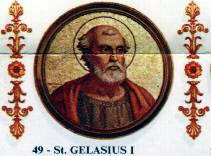Pope Gelasius I
|
Pope Saint Gelasius I |
|
|---|---|
 |
|
| Papacy began | 1 March 492 |
| Papacy ended | 19 November 496 |
| Predecessor | Felix III |
| Successor | Anastasius II |
| Personal details | |
| Birth name | Gelasius |
| Born | Unknown date Roman Africa or Rome |
| Died | 19 November 496 Rome, Ostrogothic Kingdom |
| Sainthood | |
| Feast day | 21 November |
|
Papal styles of Pope Gelasius I |
|
|---|---|
 |
|
| Reference style | His Holiness |
| Spoken style | Your Holiness |
| Religious style | Holy Father |
| Posthumous style | Saint |
Pope Gelasius I (died 19 November 496) was Pope from 1 March 492 to his death in 496. He was probably the third and last Bishop of Rome of Berber descent in the Catholic Church. Gelasius was a prolific writer whose style placed him on the cusp between Late Antiquity and the Early Middle Ages. Gelasius had been closely employed by his predecessor Felix III, especially in drafting papal documents. His ministry was characterized by a call for strict orthodoxy, a more assertive push for papal authority, and increasing tension between the churches in the West and the East.
There is some dispute regarding where Gelasius was born: according to the Liber Pontificalis he was born in Africa (natione Afer), while in a letter addressed to the Roman Emperor Anastasius he called himself "born a Roman" (Romanus natus). The latter assertion probably just means that he was born in Roman Africa before it was overrun by the Vandals.
Gelasius' election on 1 March 492 was a gesture for continuity: Gelasius inherited Felix's struggles with Eastern Roman Emperor Anastasius and the patriarch of Constantinople and exacerbated them by insisting on the removal of the name of the late Acacius, patriarch of Constantinople, from the diptychs, in spite of every ecumenical gesture by the current, otherwise quite orthodox patriarch Euphemius (q.v. for details of the Acacian schism).
The split with the emperor and the patriarch of Constantinople was inevitable, from the western point of view, because they had embraced a view of a single, Divine ("Monophysite") nature of Christ, which was a Christian heresy according to the Church of Rome. Gelasius' book De duabus in Christo naturis ("On the dual nature of Christ") delineated the Western view. Thus Gelasius, for all the conservative Latinity of his writing style, stood on the cusp of Late Antiquity and the Early Middle Ages.
...
Wikipedia
